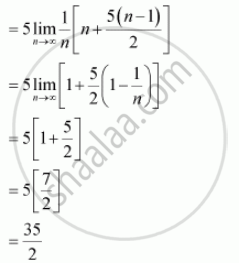Advertisements
Advertisements
प्रश्न
Evaluate the following definite integrals as limit of sums.
`int_0^5 (x+1) dx`
उत्तर


APPEARS IN
संबंधित प्रश्न
Evaluate `int_1^3(e^(2-3x)+x^2+1)dx` as a limit of sum.
Evaluate the following definite integrals as limit of sums.
`int_a^b x dx`
Evaluate the following definite integrals as limit of sums.
`int_1^4 (x^2 - x) dx`
Evaluate the definite integral:
`int_(pi/2)^pi e^x ((1-sinx)/(1-cos x)) dx`
Evaluate the definite integral:
`int_0^(pi/4) (sinx cos x)/(cos^4 x + sin^4 x)`dx
Evaluate the definite integral:
`int_0^1 dx/(sqrt(1+x) - sqrtx)`
Prove the following:
`int_1^3 dx/(x^2(x +1)) = 2/3 + log 2/3`
Prove the following:
`int_(-1)^1 x^17 cos^4 xdx = 0`
Prove the following:
`int_0^(pi/2) sin^3 xdx = 2/3`
Evaluate `int_0^1 e^(2-3x) dx` as a limit of a sum.
`int dx/(e^x + e^(-x))` is equal to ______.
`int (cos 2x)/(sin x + cos x)^2dx` is equal to ______.
If f (a + b - x) = f (x), then `int_a^b x f(x )dx` is equal to ______.
if `int_0^k 1/(2+ 8x^2) dx = pi/16` then the value of k is ________.
(A) `1/2`
(B) `1/3`
(C) `1/4`
(D) `1/5`
Evaluate : `int_1^3 (x^2 + 3x + e^x) dx` as the limit of the sum.
If f and g are continuous functions in [0, 1] satisfying f(x) = f(a – x) and g(x) + g(a – x) = a, then `int_0^"a" "f"(x) * "g"(x)"d"x` is equal to ______.
Evaluate the following:
`int_0^(pi/2) (tan x)/(1 + "m"^2 tan^2x) "d"x`
Evaluate the following:
`int_(pi/3)^(pi/2) sqrt(1 + cosx)/(1 - cos x)^(5/2) "d"x`
If f" = C, C ≠ 0, where C is a constant, then the value of `lim_(x -> 0) (f(x) - 2f (2x) + 3f (3x))/x^2` is
Left `f(x) = {{:(1",", "if x is rational number"),(0",", "if x is irrational number"):}`. The value `fof (sqrt(3))` is
What is the derivative of `f(x) = |x|` at `x` = 0?
`lim_(x -> 0) (xroot(3)(z^2 - (z - x)^2))/(root(3)(8xz - 4x^2) + root(3)(8xz))^4` is equal to
Let f: (0,2)→R be defined as f(x) = `log_2(1 + tan((πx)/4))`. Then, `lim_(n→∞) 2/n(f(1/n) + f(2/n) + ... + f(1))` is equal to ______.
The value of `lim_(n→∞)1/n sum_(r = 0)^(2n-1) n^2/(n^2 + 4r^2)` is ______.
